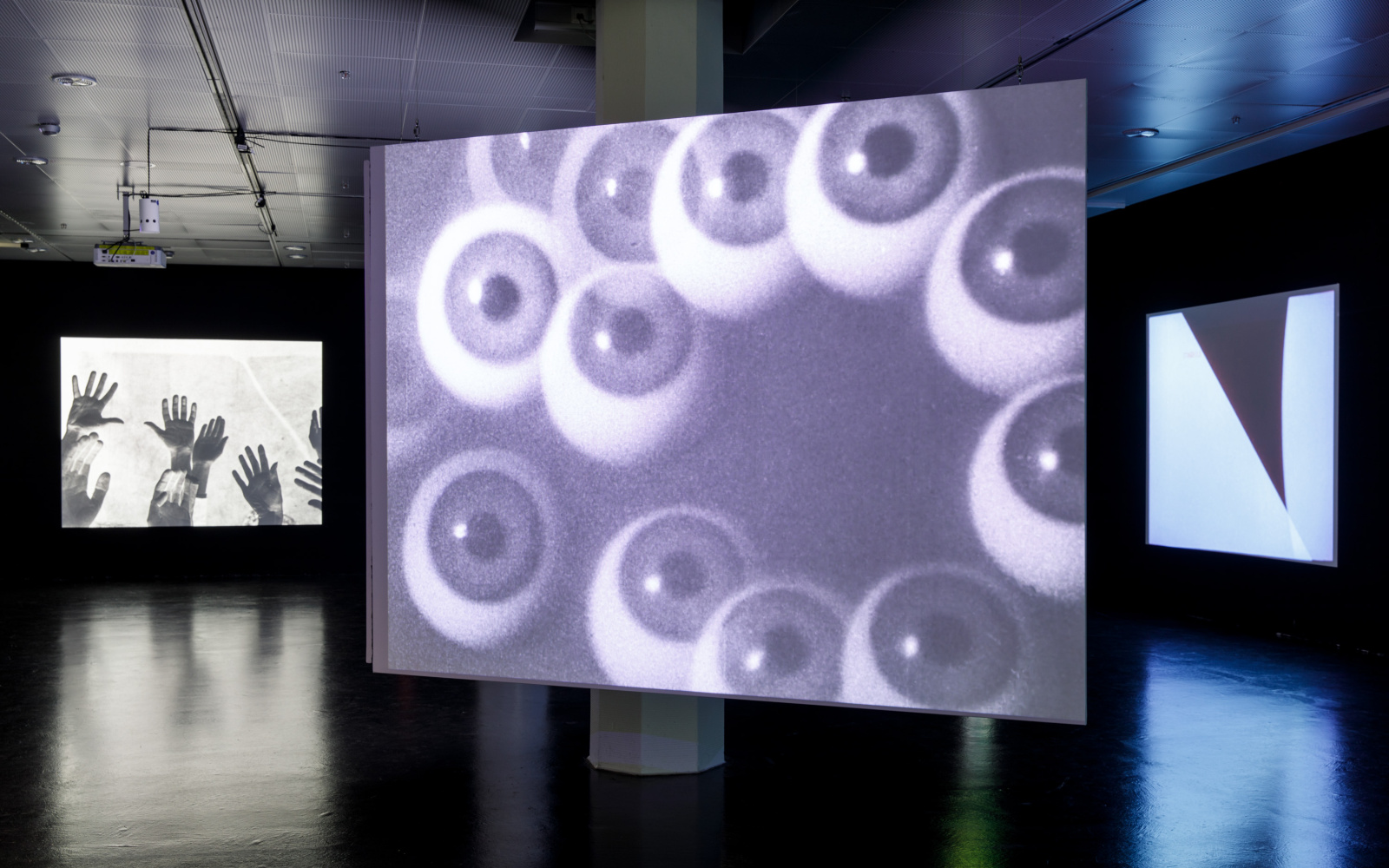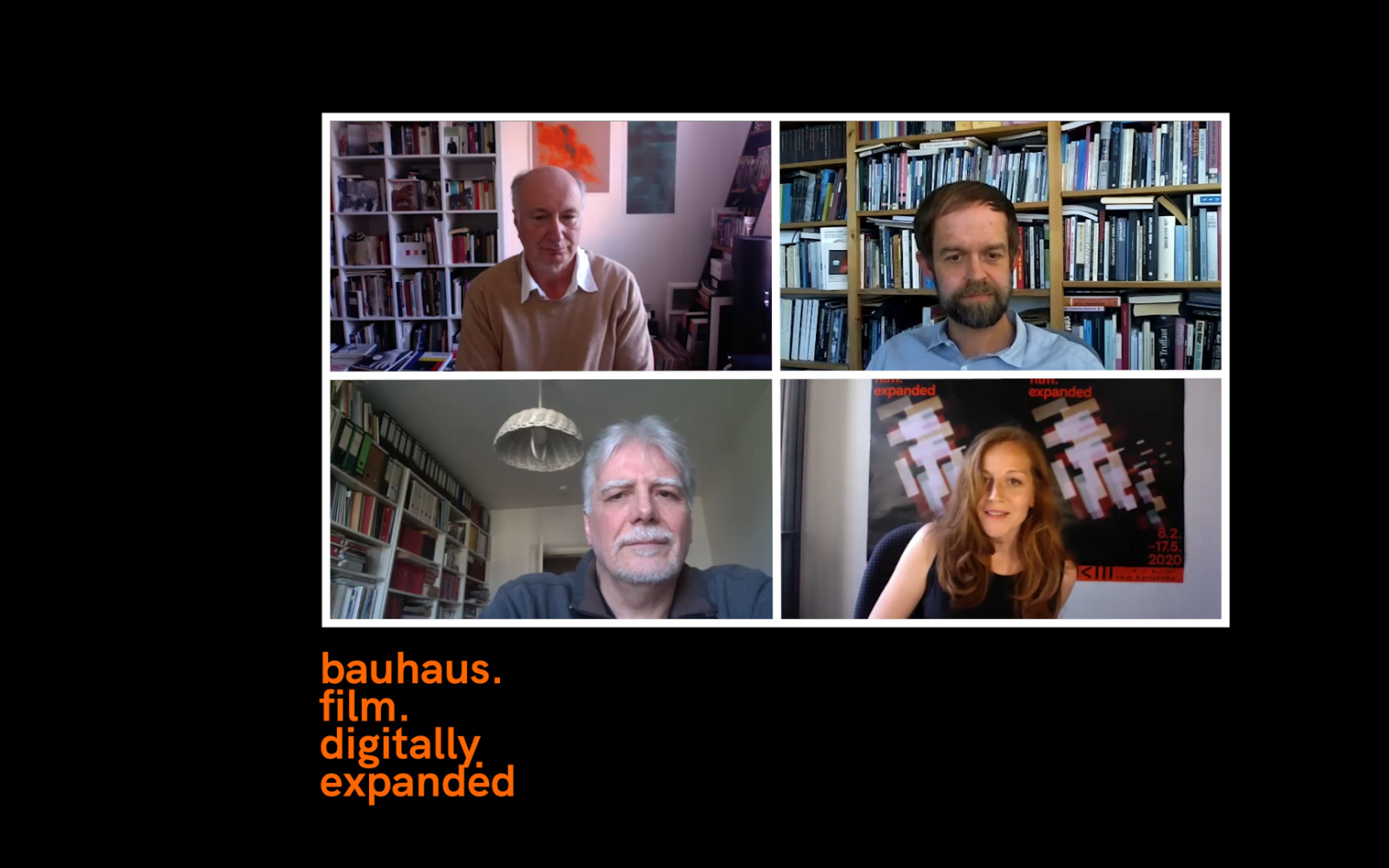Abstract Films
in the exhibition »bauhaus.film.expanded«
»The idea was very simple – that only one surface (square or rectangle) at a time should be visible on the canvas, either standing or moving to a strict rhythm.« (Werner Graeff, 1922)
The Bauhaus film makers were already working with abstract films from the early 1920s. They created film scripts for games of form and color, partly playful, partly radically formal, partly poetic. The latest research findings prove that the Bauhaus students Lore Leudesdorff and Ré Soupault (née Erna Niemeyer) were also authors of seminal works of the German film avant-garde. In some of the »Absolute Films« by Walter Ruttmann, Viking Eggeling, and Hans Richter, they were responsible for important steps in the production process. They were in charge of the drawings, the rhythms of the images, operating the animation camera, and the hand coloring of individual frames of the film.
The central idea of the Bauhaus was not to practice »l’art pour l’art«, but to create art and knowledge for as many people as possible. The development of various industrial products was preceded by research and practical research work. Many abstract films at the Bauhaus, for example, explore how moving geometric bodies behave in space. In the films, countless possibilities of the movements of forms in different directions and from different perspectives are systematically investigated.
The greatest contrast to the abstract films at the Bauhaus were the utility and advertising films, since they did not directly pursue artistic aims. Leudesdorff’s and Ruttmann’s advertising films exhibit both abstract and representational elements and reflect her special interest in the formal aesthetic vocabulary of modernism. In Alfred Ehrhardt’s cultural films, the influence of the Bauhaus is clearly visible. They deal with abstraction, archaic primal forms, surface structure, ornamentation, rhythm, polyphony, and seriality. The abstract films »Composition I/1922« and »Composition II/1922« by Werner Graeff, refer to the pure observation of form in space. Like Kurt Kranz and Kurt Schwerdtfeger, Graeff only realized his films later at the Werkkunstschule Folkwang. His black and white »Composition« was created in 1959 and the colored version not until 1977.
Films in the exhibition »bauhaus.film.expanded«
-
Abstract Films
Heinrich Brocksieper, »Flächen Perpelleristisch«, DE 1927–1930
Film, b/w, silent, 02:14 by 25 frames/sec
Beta SP
© Utz BrocksieperHeinrich Brocksieper, »Duck«, DE 1927–1930
35mm, b/w, silent, 00:45 by 25 frames/sec
Digital copy of 35mm film: ZKM | Karlsruhe, reconstructed on Beta SP
© Utz BrocksieperHeinrich Brocksieper, »Näherin« [Female Sewer], DE 1927–1930
35mm, b/w, silent, 00:49 by 25 frames/sec
Digital copy of 35mm film: ZKM | Karlsruhe, reconstructed on Beta SP
© Utz BrocksieperAlfred Ehrhardt, »Dance of the Shells«, DE 1956
35mm, b/w, Ton, 09:36 by 24 frames/sec
Digital copy of 35mm negative: Alfred Ehrhardt Stiftung
© Alfred Ehrhardt StiftungAlfred Ehrhardt, »Corals, Sculptures of the Seas«, DE 1964
35mm, b/w, silent, music: Oskar Sala, 11:30 of 24 frame/sec
Digital copy of a 35mm negative
© Alfred Ehrhardt StiftungHans Richter, Ré Soupault, »Filmstudie« [Film Studies], DE 1927/1928
35mm, b/w, silent, 04:22 by 22 frames/sec
Digitized of a 35mm negative-back-up copy: Stiftung Deutsche Kinemathek
Stiftung Deutsche Kinemathek
© Marion von HofackerViking Eggeling, »Symphonie Diagonale«, DE 1924/1925
35mm, b/w, silent, 07:50 by 16 frames/sec
Digitized of a 35mm negative-back-up copy: Svenska Filminstitutet
digitized by: ZKM | Karlsruhe with funding from The German Federal Film Board
Courtesy of The Swedish Film InstituteKurt Kranz, »Schwarz : Weiß/Weiß : Schwarz«, [Black : White:White : Black], DE 1927/1972
35mm, b/w, silent, 02:05 by 24 frames/sec
Digital copy of a 16mm positive: ZKM | Karlsruhe
© Ingrid KranzKurt Kranz, »Twenty Pictures from the Life of a Composition«, DE 1927/1928/1972
35mm, b/w, silent, 02:11 by 24 frames/sec
Digital copy of a 16mm positive: ZKM | Karlsruhe
© Ingrid KranzKurt Kranz, »Color Film called Leporello«, DE 1927/1972
35mm, b/w, silent, 05:25 by 24 frames/sec
Digital copy of a 16mm positive: ZKM | Karlsruhe
© Ingrid KranzKurt Kranz, »The Heroic Arrow«, DE 1927/1972
35mm, b/w, silent, 05:25 by 24 frames/sec
Digital copy of a 16mm positive: ZKM | Karlsruhe
© Ingrid KranzAlfred Ehrhardt, »Play of Spirals. From the Architecture of Sea Snails«, DE 1951
35mm, b/w, music: J. S. Bach, 15:27 by 24 frames/sec
Digital copy of a 35mm Negative
© Alfred Ehrhardt StiftungWerner Graeff, »Composition I/1922«, DE 1922/1977
16mm, b/w, silent, 01:45 by 24 frames/sec
Digital copy of 16mm positive: Stiftung Deutsche Kinemathek
© Stiftung Deutsche KinemathekWerner Graeff, »Composition II/1922«, DE 1922/1959
16mm, b/w, silent, 01:30 by 24 frames/sec
digital copy of 16mm positive: Stiftung Deutsche Kinemathek
© Stiftung Deutsche KinemathekHans Richter, »Haunted Morning«, DE 1928
35mm, color, silent, 06:39 by 22 frames/sec
digital copy of 35mm back-up copy: Stiftung Deutsche Kinemathek
© Marion von HofackerJulius Pinschewer, Walter Ruttmann, Lore Leudesdorff, »Der Aufstieg« [The Climbing], DE 1926
35mm, color, sound, music, 02:01 by 16 frames/sec
Digital copy of a 35mm positive
© Stiftung Deutsche Kinemathek
© Martin LoiberdingerJulius Pinschewer, Walter Ruttmann, Lore Leudesdorff, »Play of the Waves«, DE 1925
35mm, color, silent, 01:46 by 16 frames/sec
Digital copy of 35mm positive: Stiftung Deutsche Kinemathek
© Stiftung Deutsche KinemathekJulius Pinschewer, Walter Ruttmann, Lore Leudesdorff, »The Paradise Found Again«, DE 1925
35mm, b/w, silent, 04:42 by 16 frames/sec
Digital copy of a 35mm positive
© Stiftung Deutsche KinemathekWalter Ruttmann, Lore Leudesdorff, »Opus III«, DE 1924/1925
35mm, colour (originally tinted), music: Hanns Eisler, 03:21 by 16 frames/sec
Digitized of various 35mm positives: Filmmuseum München
© Filmmuseum MünchenWalter Ruttmann, Lore Leudesdorff, »Opus IV«, DE 1924/1925
35mm, colour (originally tinted), silent, 03:56 by 16 frames/sec
digitized of various 35mm positives: Filmmuseum München
© Filmmuseum München
bauhaus.film.digitally.expanded - Rahmenprogramm: Abstrakte Filme
Some films in this section were available online until August 23, 2020. The release was accompanied by a live discussion on May 7, 2020 at 6 pm between Malte Hagener, Markus Heltschl and Stefan Drößler, moderated by Teresa Retzer.

